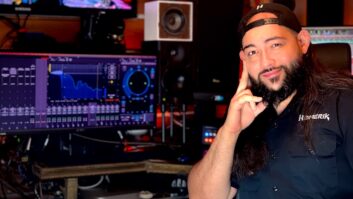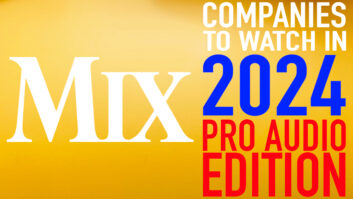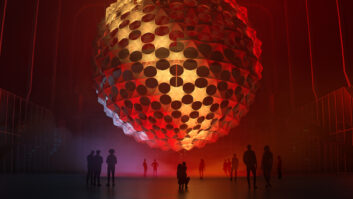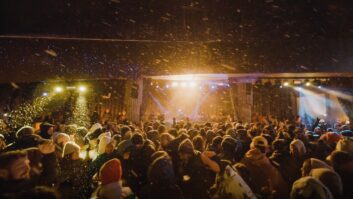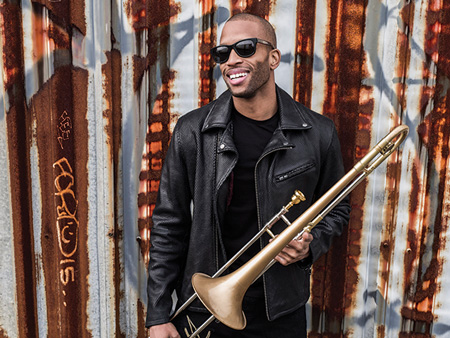
Troy Andrews, aka Trombone Shorty, has ruled Billboard’s Contemporary Jazz chart. He performed twice for President Obama at the White House and appeared in sthe HBO series Treme. His music is beloved in New Orleans and beyond for the way he re-imagines the musical heritage of his city, casting influences from Louis Armstrong to Fats Domino to the Meters into a feel-good second-line stew. A masterful singer, and tuba and Wurly player, as well as trombonist, Shorty brings the party to the people.
“It’s up to us to make sure the music continues,” Andrews says. “The Neville Brothers and the Meters don’t sound anything like Fats Domino. They moved the music forward. I take from the foundation they laid down and I like to think we are moving the music forward too.”
Andrews’ influences come to bear on Parking Lot Symphony (Blue Note). The album was recorded in New Orleans’ Treme neighborhood in a renovated 1847 gothic-revival church-turned-studio called The Esplenade. Andrews, producer Chris Seefried, engineer Seth Atkins Horan, and a funky band and gospel choir gathered in the studio’s 3,400-square-foot live room.
“The Esplenade really contributed to the sound of Parking Lot Symphony,” Seefried says. “When we put up the first two tracks we started feeling this swampy Southern sound. We recorded the basics live to a MCI JH-24 24-track 2-inch tape machine and a Rupert Neve Designs Shelford 5088 48-channel console [in Studio A].“The room really added to the music, which can happen when you record real musicians in a real room with all the harmonics of the room. The way the harmonics naturally intermingle and the way the reverbs hit within the room, that creates these free musical tones that you can’t get if you’re stacking tracks. That was a beautiful thing; the basics sounded so full and natural. [Blue Note president] Don Was brought me in on this project, and he thought it sounded so beautiful as well.” Additional recording and mixing were done at Gnu Gnome, Seefried and Horan’s studio in Hollywood, and mastering was by Bernie Grundman. So, Parking Lot Symphony is also the sound of new and the old worlds, of germ-free L.A. mixing suites meeting the holy vibrations of one of the oldest cities in America.
After creating demos in Reason, Akai MPC and Native Instruments Maschine—or by humming into his smart-phone—Andrews (on Wurlitzer) and his band tracked basics at The Esplenade, to which he overdubbed Rhodes, trombone, trumpet, vocals, glockenspiel, vibraphone, 1956 Hammond C3 Organ and marching snare drum.
Andrews overdubbed his vocals last, with only Horan and Seefried present. “I’m not good at punching in vocals,” Andrews says. “I work to get a good performance. I like to get my horn parts down first, then the band leaves and I cut vocals with the engineer phone—Andrews (on Wurlitzer) and his band tracked basics at The Esplenade, to which he overdubbed Rhodes, trombone, trumpet, vocals, glockenspiel, vibraphone, 1956 Hammond C3 Organ and marching snare drum.

“I really wanted to express the sound of New Orleans,” Seefried says. “Troy’s music and the way he plays is very specific. I wanted to show everything he does, so we had him play all these different instruments. I knew the live setting would enable us to go in different musical directions with a single through-line. I wouldn’t have thought of bringing in a choir had I not been standing in this massive church. And the Esplenade has a huge pipe organ donated by Andrew Carnegie. It’s a spiritual, sacred place.
Outside of selected UAD components, plug-ins played no role on Parking Lot Symphony. An original Echoplex and a Tel-Ray AD-N-Echo Electronic Sound Chamber were used to augment the natural reverberant sound of the room. “It’s a reverb-delay from the ’60s that creates a delayed reverb by a spinning oil can inside its box,” Horan explains. “It has a contact pickup and a mic. It works like a plate reverb. It gives this washy, warbly delayed reverb. It literally has an oil can spinning around. They had to stop making them when they discovered the oil was carcinogenic. An outboard deadly device!”
Horan is a quadruple Grammy winner, via his long association with Latin pop star Draco Rosa. Speaking from their their Hollywood studio Gnu Gnome, Horan revealed the miking details of the Parking Lot Symphony sessions.
“There’s a lot of room miking,” he notes. “That was a huge part of it. I used pairs of Neumann M150s and Coles 4038s. The M150s were way up, around 20 feet, and far back, placed initially for the drums. I left them there for overdubs. The drums were in the middle of the room. We baffled off behind the drums to get more presence on the close mics. The room mics were behind the baffles: a pair of Coles 4038s for closer room mics, 15 feet away from the kit. We utilized the room mics for everything. We moved the musicians, including the choir, to match the room mic placement. We recorded stomps and claps and a choir and a marching band.
“We recorded 80 percent straight to tape,” Horan continues. “The Neve 5088 console is really quiet; we usually used its internal preamps too. It sounded warm and fat. It has buttons that let you choose from three different levels of harmonic saturation. You could get a saturated, older Neve sound or a cleaner sound just by pushing these buttons. It pushed the harmonic distortion in an interesting way. The studio was loaded with good compressors and the EQs and internal mic preamps on the Neve board are great. I used the studio’s Neve 1073 and API 512s too.”
Trombone Shorty’s band recorded in The Esplenade’s huge live room, with guitar, bass and keyboard amps isolated separately. Horns were also tracked in the live room, as well as in an iso booth, with bleed encouraged. Horan maximized the ambience by employing room mics for all instruments with baffling, but close-miking “smaller sounding stuff.”
Andrews’ vocal chain comprised a Telefunken ELAM 251, Neve 1073 mic preamp and UREI 1176 compressor. A spaced pair of Coles 4038s were placed in front of the five-voice choir, along with a pair of Neumann M150s to capture the room sound, placed 40 feet back and 20 feet high.
“I used an RCA 44 and a Neumann U67 to close-mic Shorty, placed pretty close, within a few feet of his instrument,” Horan explains. “For overdubs, including section overdubs, I used a stereo pair of Coles 4038s and two M150s placed way back. We ended up using that setup on most of the recording. It’s fun to balance all the elements in a giant room. I try not to rely on plug-ins after the fact. We used reverbs and effects here and there, but we wanted to get an interesting sound from the room, not something from the box.”
For Rhodes and Wurly, Horan miked a Fender Champ using a Royer 121, doubling that setup for horn overdubs. “Royers are really well-built,” he says. “You can put them on a Marshall and they don’t blow up. They’re really full and warm-sounding, and great on horns or guitars. They remove the shrillness. They can handle huge SPLs.”
The studio’s 1956 Hammond C2 organ was captured using two AKG C414s on top with an AKG D12 on the bottom speaker. Shure SM57 and Royer 121s covered guitar amps, the 57 positioned on-axis to get “a pretty present signal” and the Royer on the grille but off-axis. “That gives you a full ribbon mic sound with more low end; then I blend the two together rather than rely on EQ,” Horan says. On bass, the engineer used an Electro-Voice RE20 and a DI.
On drums, Horan used Coles 4038s and M150s as room mics, a pair of AKG C12As in XY fashion as overheads. A Shure SM57 covered the top snare head, followed by a Neumann KM84 on the strainer side. AKG C414s covered toms; an AKG D12 was placed inside the bass drum, a Neumann FET 47 was placed one foot outside the bass drum. A Yamaha Subkick was also used. Another KM84 picked up hi-hat, while an RCA44 was used as a mono mic, placed four feet in front of the kit off to the side, about rack tom height.
“It was a lot of fun to have this unique acoustic environment,” Horan says. “A big space really helped the energy of the whole record.”
“I try to let the spirit come alive wherever I need it to be,” Andrews says. “I’m working hard in every musical situation. Playing 100 percent from the heart and the soul is what the city of New Orleans is all about. ”




